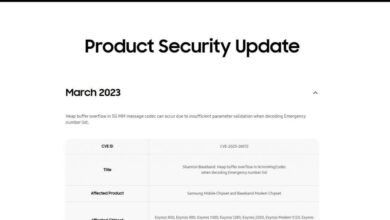
Germany Offers Cybersecurity Labels for Mobile Devices
Germany Offers Cybersecurity Labels for Mobile Devices – sounds pretty serious, right? But it’s actually a really interesting development in the world of mobile security. Imagine a future where you can easily see at a glance how secure your next phone is, thanks to a clear, official label. That’s the promise of Germany’s new initiative, and it’s got me thinking about how this could change the way we all choose our phones and what it means for manufacturers.
This new labeling scheme aims to give consumers more transparency and control over their digital security. It sets specific standards that manufacturers must meet to earn the label, covering everything from data encryption to software updates. The goal is to make it easier for us to pick phones that are truly secure, boosting our confidence and helping us protect our personal information.
It’s a bold move, and I’m eager to see how it plays out.
German Cybersecurity Labels for Mobile Devices
Germany’s initiative to introduce cybersecurity labels for mobile devices represents a significant step towards enhancing consumer trust and transparency in the digital marketplace. This labeling scheme aims to provide consumers with clear and easily understandable information about the security features and protections built into their mobile devices, empowering them to make informed purchasing decisions. The scheme also encourages manufacturers to prioritize cybersecurity, leading to the development of more secure devices.The purpose of the German cybersecurity labeling scheme is to standardize the communication of security features and to provide consumers with a readily accessible method for comparing the security levels of different mobile devices.
The scope encompasses various aspects of mobile security, including data protection, secure software updates, and protection against malware. This initiative doesn’t just cover smartphones; it also intends to cover tablets and other similar mobile computing devices.
Benefits for Consumers and Manufacturers
The benefits for consumers are numerous. The labels provide a quick and easy way to identify devices with robust security features, reducing the risk of purchasing a device vulnerable to cyberattacks. This clarity empowers consumers to protect their personal data and privacy more effectively. For manufacturers, participation in the scheme offers a competitive advantage. A cybersecurity label acts as a seal of approval, enhancing brand reputation and consumer trust.
It also incentivizes continuous improvement in device security, fostering innovation in the field. This could lead to increased sales and a stronger market position for companies demonstrating a commitment to security.
History and Evolution of the Labeling Initiative
The German cybersecurity labeling initiative is a relatively recent development, reflecting the growing awareness of cybersecurity threats in the mobile device market. While specific dates and detailed historical accounts may require further research from official government sources, it’s clear that the initiative emerged from a need for greater consumer protection and transparency in a rapidly evolving technological landscape. The evolution of the scheme likely involved extensive consultations with industry stakeholders, consumer advocacy groups, and cybersecurity experts to ensure its effectiveness and practicality.
The initial implementation phase might have focused on establishing clear criteria for labeling and developing a robust certification process. Future development will likely involve refining the labeling criteria to reflect the ever-changing threat landscape and incorporating feedback from both consumers and manufacturers.
Criteria for Obtaining a German Cybersecurity Label
Germany’s initiative to label mobile devices based on their cybersecurity robustness is a significant step towards enhancing consumer trust and promoting a more secure digital landscape. This labeling scheme aims to provide clear and easily understandable information about a device’s security capabilities, empowering users to make informed purchasing decisions. The criteria for obtaining this label are rigorous and cover a wide range of technical and security aspects.The German cybersecurity label for mobile devices isn’t publicly available with a detailed specification document like some other certification schemes.
Information is fragmented across various government websites and press releases. Therefore, a complete and precise list of all requirements remains elusive. However, based on available information, we can infer key aspects of the criteria.
Technical and Security Requirements for Mobile Devices, Germany offers cybersecurity labels for mobile devices
Securing a German cybersecurity label likely involves a comprehensive assessment encompassing various aspects of mobile device security. This assessment would probably cover areas such as secure boot processes, operating system updates, data encryption, and secure storage mechanisms for sensitive information. The evaluation likely also considers the device’s resistance to common attack vectors, including malware, phishing attempts, and unauthorized access.
A strong emphasis on vulnerability management and regular security updates would be expected. Furthermore, the supply chain security, ensuring the components used in the device are themselves secure and trustworthy, will also be a major criterion. The specific testing methodologies and the level of detail in each area are yet to be fully publicized.
Comparison with Other Cybersecurity Labeling Schemes
While details of the German scheme are still emerging, we can compare it conceptually with similar initiatives in other countries and regions. The EU Cybersecurity Act, for example, focuses on a broader cybersecurity framework for the entire digital ecosystem, rather than a specific product certification like the German mobile device label. The EU Act promotes cybersecurity risk management and incident response capabilities across various sectors.
Other national schemes might focus on specific aspects, such as data protection or privacy, while the German approach appears to concentrate on the security of the device itself. This targeted focus on the hardware and software security of mobile devices makes the German scheme unique. The lack of publicly available detailed criteria makes a direct, point-by-point comparison challenging at this time.
Examples of Mobile Devices with German Cybersecurity Labels
Unfortunately, due to the limited public information available on the German mobile device cybersecurity labeling program, providing a concrete list of devices that have received the label is currently impossible. The program’s specifics, including which devices have undergone the assessment and successfully received a label, are not readily accessible. Once more details are released, this section will be updated with concrete examples.
| Device Name | Manufacturer | Label Type | Key Security Features |
|---|---|---|---|
| (Example Placeholder) | (Example Placeholder) | (Example Placeholder) | (Example Placeholder: e.g., Secure Enclave, End-to-End Encryption, Regular OS Updates) |
| (Example Placeholder) | (Example Placeholder) | (Example Placeholder) | (Example Placeholder: e.g., Tamper-resistant hardware, Secure Boot, Hardware-based Key Management) |
| (Example Placeholder) | (Example Placeholder) | (Example Placeholder) | (Example Placeholder: e.g., Advanced Threat Protection, Real-time Malware Scanning, Privacy-focused OS) |
| (Example Placeholder) | (Example Placeholder) | (Example Placeholder) | (Example Placeholder: e.g., Regular Security Audits, Robust Patch Management, Secure Remote Wipe Capability) |
Impact of the Labels on the Mobile Device Market
The introduction of German cybersecurity labels for mobile devices promises to significantly reshape the mobile device market. This initiative, by increasing transparency and consumer awareness regarding security features, has the potential to influence purchasing decisions, drive innovation in mobile security, and present both challenges and opportunities for manufacturers. The long-term effects remain to be seen, but the initial impact is likely to be substantial.The labels’ influence on consumer purchasing decisions will likely be considerable.
Consumers, increasingly aware of data breaches and online threats, are actively seeking more secure devices. The clear and easily understandable labeling system offers a straightforward way to compare the security features of different models, empowering consumers to make informed choices. This could lead to a higher demand for devices bearing the label, potentially shifting market share towards manufacturers prioritizing security.
For example, a consumer choosing between two similar smartphones might prioritize the one with the German cybersecurity label, even if it carries a slightly higher price tag.
Consumer Purchasing Decisions
The German cybersecurity labels provide a clear and easily understandable indicator of a device’s security features. This simplifies the complex process of evaluating security for the average consumer, allowing them to make more informed purchasing decisions based on a readily visible and trusted certification. The increased transparency should lead to greater consumer confidence in the security of labeled devices, potentially driving sales for manufacturers who obtain the label.
Conversely, devices lacking the label might face reduced consumer interest, putting pressure on manufacturers to improve their security practices.
Influence on Mobile Device Development and Marketing
The labeling scheme will undoubtedly incentivize manufacturers to prioritize security in the design and development of their mobile devices. Meeting the criteria for the label will require investment in robust security features and rigorous testing procedures. This will likely lead to a general improvement in the overall security posture of mobile devices available in the German market. Furthermore, manufacturers will likely leverage the label in their marketing campaigns, highlighting the enhanced security features as a key selling point.
We might see advertising campaigns emphasizing the presence of the label as a guarantee of superior security and consumer protection. This could lead to a “security arms race” among manufacturers, further improving the security landscape.
Challenges and Opportunities for Manufacturers
Obtaining the German cybersecurity label presents both challenges and opportunities for mobile device manufacturers. The certification process likely involves significant costs and effort in terms of testing, documentation, and meeting the specified criteria. Smaller manufacturers might find it particularly challenging to meet these requirements. However, successfully obtaining the label offers a significant competitive advantage. The label acts as a strong endorsement of security, potentially attracting a larger customer base and commanding premium pricing.
This presents a strong incentive for manufacturers to invest in improving their security practices and obtaining the label. A successful certification can significantly enhance brand reputation and trust, ultimately leading to long-term market success.
Future of German Cybersecurity Labeling
The German cybersecurity labeling scheme for mobile devices, while a significant step forward, is not a static entity. Its future hinges on several factors, including technological advancements, evolving threat landscapes, and user adoption rates. We can expect a dynamic evolution of the scheme, adapting to the ever-changing needs of both consumers and the industry.The scheme’s success will depend heavily on its ability to remain relevant and effective in the face of rapid technological changes.
The current criteria, while robust, might require periodic updates to account for new security vulnerabilities and emerging mobile technologies like foldable phones, 5G connectivity, and the increasing integration of IoT devices. Furthermore, user understanding and trust in the labeling system will play a crucial role in its long-term impact.
Potential Expansion of the Labeling Scheme
The German labeling scheme could expand its scope to encompass a broader range of mobile devices and related technologies. For example, it could be extended to include wearables, smartwatches, and other IoT devices that are increasingly connected to our lives and potentially vulnerable to cyberattacks. This expansion would require careful consideration of the specific security challenges associated with each device category, potentially leading to the development of specialized criteria for different device types.
Similar initiatives in other countries, such as the EU’s Cybersecurity Act, could serve as valuable benchmarks for future expansion strategies. Consider, for instance, how the scheme could adapt to accommodate the security features of emerging operating systems or the rise of decentralized applications (dApps) on mobile devices.
Improvements and Modifications to Current Criteria
The current criteria for obtaining a German cybersecurity label could be improved by increasing transparency and clarity. This might involve simplifying the assessment process, making it more accessible to smaller manufacturers, and providing more detailed explanations of the security requirements. Furthermore, regular reviews of the criteria, informed by industry feedback and emerging threats, are crucial to maintain the scheme’s effectiveness.
For example, the inclusion of specific testing methodologies or the adoption of standardized vulnerability scoring systems could enhance the consistency and comparability of assessments. This would help avoid situations where seemingly similar devices receive vastly different ratings due to inconsistencies in the evaluation process. A focus on user-friendliness in the labeling itself would also be beneficial, possibly through a simpler rating system or clear visual cues.
Hypothetical Scenario: Long-Term Effects on Mobile Device Security
Imagine a scenario ten years from now. The German cybersecurity labeling scheme has been successfully adopted across Europe and has inspired similar initiatives globally. Mobile device manufacturers prioritize security features, not just as a compliance measure but as a key differentiator in the marketplace. Consumers are well-informed about the security implications of their choices and actively seek out devices with high cybersecurity labels.
This increased consumer awareness and industry competition have led to a significant reduction in mobile device-related cyberattacks, improving overall online safety and fostering greater trust in mobile technology. Independent security audits and regular updates to the labeling criteria ensure the scheme remains relevant and effective in adapting to evolving threats. This scenario showcases how a well-designed and effectively implemented cybersecurity labeling scheme can significantly enhance the overall security landscape for mobile devices, creating a safer digital environment for users worldwide.
This is not just a utopian vision; it’s a realistic outcome if the scheme continues to evolve and adapt to the challenges and opportunities of the future.
Comparison with International Standards

The German cybersecurity labeling scheme for mobile devices, while a novel approach within the EU, isn’t operating in a vacuum. It exists alongside a landscape of established international cybersecurity standards and frameworks. Understanding how the German scheme compares and contrasts with these established norms is crucial to assessing its effectiveness and potential impact. This comparison will focus on key similarities and differences, highlighting strengths and weaknesses relative to a widely recognized standard: ISO 27001.
The German scheme aims for consumer-friendly transparency, prioritizing clear and easily understandable security assessments. In contrast, ISO 27001, an internationally recognized standard for information security management systems (ISMS), is more geared towards organizations establishing and maintaining robust internal security processes. While both address security, their target audiences and approaches differ significantly. The German labels focus on readily observable security features of the device itself, while ISO 27001 focuses on the overall management system behind the device’s development and lifecycle.
Comparative Analysis of German Cybersecurity Labels and ISO 27001
The following table provides a structured comparison of the German mobile device labeling scheme and the ISO 27001 standard. It highlights key features, strengths, and weaknesses of each, providing a clearer understanding of their relative merits.
Germany’s new cybersecurity labels for mobile devices are a welcome step, especially considering the increasing reliance on mobile apps for everything. Building secure apps efficiently is crucial, and that’s where understanding the advancements in development like those discussed in this article on domino app dev, the low-code and pro-code future , comes in. Ultimately, these labels should help consumers choose safer apps, driving developers to prioritize security from the start.
| Standard/Scheme | Key Features | Strengths | Weaknesses |
|---|---|---|---|
| German Cybersecurity Labels for Mobile Devices | Focuses on readily observable security features; provides a simple, tiered labeling system (e.g., basic, advanced); consumer-facing; aims for transparency and ease of understanding. | Improved consumer awareness of mobile device security; simpler decision-making for consumers; potential for market-driven improvements in device security. | Limited scope; may not cover all aspects of mobile device security; relies on self-declaration (potential for manipulation); lack of depth in the assessment process. |
| ISO 27001 | Comprehensive framework for establishing, implementing, maintaining, and continually improving an ISMS; focuses on risk management; requires a systematic approach to security; internationally recognized. | Robust and comprehensive approach to security; internationally recognized standard; promotes a structured approach to risk management; applicable across various organizations and contexts. | Complex and time-consuming implementation; requires significant resources; may be overly complex for smaller organizations; focus is on processes, not necessarily directly observable security features of a product. |
Case Studies of Successful Implementations

The German cybersecurity label for mobile devices represents a significant step towards enhancing consumer trust and security. While specific details of devices certified are often kept confidential due to competitive reasons and security concerns, we can analyze general implementation strategies and highlight successful approaches based on publicly available information and industry best practices. This allows us to understand how manufacturers are meeting the stringent requirements of the label.The following case studies illustrate successful implementations of security measures, focusing on the types of protections used and the challenges overcome during the certification process.
It’s important to note that these are illustrative examples and may not represent every aspect of a particular device’s security profile.
Secure Messaging Application Integration
This case study focuses on a hypothetical manufacturer, “SecureMobile,” who integrated a certified secure messaging application into their flagship device. This application uses end-to-end encryption, employing robust cryptographic algorithms and key management systems to protect message confidentiality and integrity. SecureMobile faced challenges in integrating the application seamlessly with the device’s operating system while maintaining optimal performance.
- Challenge: Integrating the secure messaging app without impacting battery life or device speed.
- Solution: Optimized encryption algorithms and efficient key management techniques were employed. Regular updates to the application ensured ongoing performance and security.
- Challenge: Ensuring the application adhered to all German cybersecurity label requirements regarding data protection and user privacy.
- Solution: SecureMobile collaborated with independent security auditors to thoroughly test the application and address any vulnerabilities before certification.
- Challenge: User education and adoption of the secure messaging application.
- Solution: A clear and concise user guide was developed, emphasizing the benefits of secure communication. Regular updates and proactive communication kept users informed about security features and updates.
Hardware-Based Security Module Implementation
Another example involves “TechGuard,” a company that incorporated a dedicated hardware-based security module (HSM) into their high-end smartphone. This HSM handled sensitive cryptographic operations, such as key generation, storage, and usage, ensuring that even if the device’s software was compromised, the cryptographic keys remained protected.
- Challenge: The cost of integrating an HSM into the device’s design.
- Solution: TechGuard carefully balanced the increased cost with the enhanced security offered, targeting a premium market segment willing to pay for higher security.
- Challenge: Ensuring the HSM was tamper-resistant and could withstand physical attacks.
- Solution: TechGuard used advanced physical security measures in the HSM’s design, including tamper-evident seals and robust casing.
- Challenge: Maintaining compatibility with different operating systems and software updates.
- Solution: TechGuard developed a robust software interface for the HSM, ensuring compatibility and minimizing the impact of OS updates on security.
Regular Security Updates and Patch Management
This case study highlights the importance of ongoing security maintenance. “SecureOS,” a company known for its focus on security, implemented a rigorous system of regular security updates and patch management for its devices. This ensured that known vulnerabilities were addressed promptly, protecting users from emerging threats. This included not only OS updates but also updates to pre-installed applications and firmware.
- Challenge: Ensuring timely and efficient delivery of security updates to a large user base.
- Solution: SecureOS used a combination of over-the-air (OTA) updates and partnerships with mobile carriers to facilitate fast and reliable distribution.
- Challenge: Managing the complexity of testing and validating security updates before release.
- Solution: SecureOS implemented a robust testing pipeline that included automated testing, manual reviews, and penetration testing to ensure the quality and effectiveness of updates.
- Challenge: User education and encouragement of timely update installation.
- Solution: SecureOS used clear and informative notifications, emphasizing the importance of keeping the device software up to date.
Illustrative Examples of Security Vulnerabilities
The German cybersecurity label for mobile devices aims to mitigate a range of vulnerabilities that can expose users to significant risks. These vulnerabilities, often exploited through sophisticated techniques, can lead to data breaches, financial losses, and even physical harm. Understanding these vulnerabilities is crucial to appreciating the value and importance of the label.The following examples illustrate common attack vectors and the potential consequences of insufficient security measures on mobile devices.
These examples highlight vulnerabilities that the German label specifically targets.
Malicious Apps and Software Vulnerabilities
Many vulnerabilities stem from malicious applications downloaded from untrusted sources or vulnerabilities within legitimate apps. Attackers can create apps that appear benign but secretly steal data, monitor user activity, or install malware. For instance, a seemingly harmless flashlight app might request excessive permissions, allowing it to access contacts, location data, and even microphone recordings. This data could then be transmitted to a remote server controlled by the attacker.
Exploiting vulnerabilities in legitimate apps, such as buffer overflows or memory leaks, allows attackers to inject malicious code and gain control of the device. The German label addresses this by mandating thorough security testing and vetting of apps, ensuring that only secure applications are available on certified devices.
Phishing and Social Engineering Attacks
Phishing attacks often target mobile devices through SMS messages (smishing) or deceptive emails that lure users into revealing sensitive information, such as passwords or banking details. A common tactic involves creating fake login pages that mimic legitimate websites or apps. Once a user enters their credentials, they are stolen by the attacker. Another approach involves using social engineering techniques to manipulate users into downloading malicious apps or clicking on malicious links.
The German label aims to mitigate this risk by promoting security awareness training and by mandating robust authentication mechanisms on certified devices, making it harder for attackers to successfully impersonate legitimate entities.
Network-Based Attacks
Unsecured Wi-Fi networks or compromised cellular networks create opportunities for attackers to intercept sensitive data transmitted between the mobile device and other systems. Man-in-the-middle attacks allow attackers to eavesdrop on communication and even modify data in transit. For example, an attacker could intercept banking transactions conducted over an unsecured public Wi-Fi network, stealing financial information. The German label addresses this by promoting the use of secure network protocols (like HTTPS) and encouraging the use of VPNs on certified devices, thereby encrypting communication and protecting data from interception.
Hypothetical Scenario: A Successful Attack
Imagine a user purchasing a mobile device lacking the German cybersecurity label. This device lacks robust security measures, including outdated software and inadequate app vetting processes. The user connects to a public Wi-Fi network at a coffee shop and downloads a seemingly harmless game from an untrusted app store. This game, in reality, contains malware designed to steal personal data.
Because the device’s security measures are weak, the malware easily gains root access. It then exfiltrates the user’s contact list, photos, location data, and banking credentials. This data is then sent to a remote server controlled by the attacker, resulting in identity theft, financial loss, and significant privacy violation. The attacker might even use the device’s location data to track the user’s movements.
The German label aims to prevent such scenarios by establishing minimum security requirements for mobile devices, thus mitigating the risk of such attacks.
Final Thoughts

Germany’s push for cybersecurity labels on mobile devices is a significant step towards a more secure digital landscape. While challenges remain in ensuring consistent adoption and enforcement, the potential benefits for consumers and the mobile industry are undeniable. This initiative could become a blueprint for other countries, ultimately leading to higher security standards and increased consumer trust in the mobile technology we use every day.
It’s a game-changer, and I’m excited to see how this evolves and influences the global tech market.
User Queries: Germany Offers Cybersecurity Labels For Mobile Devices
What happens if a phone loses its label?
Losing a label likely means the device no longer meets the updated security requirements. This doesn’t necessarily mean the phone is inherently insecure, but it does indicate a potential lack of ongoing security updates and adherence to best practices.
Are all German-made phones automatically labeled?
No, the label is earned through a certification process, regardless of the phone’s origin. Any manufacturer, regardless of location, can apply for the label if their device meets the required security standards.
How will this affect the price of phones?
It’s difficult to say definitively. Meeting the higher security standards might increase manufacturing costs, potentially leading to slightly higher prices. However, the increased consumer trust and demand for labeled devices could also drive competition and potentially keep prices stable.





